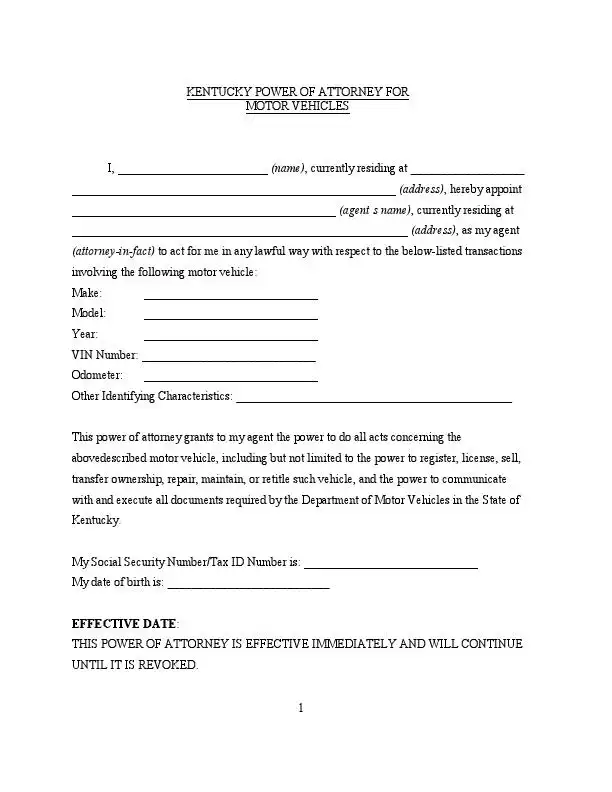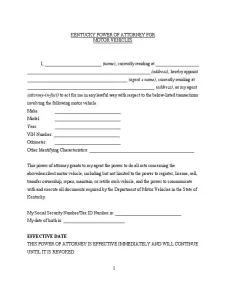Kentucky Motor Vehicle Power of Attorney Form
The Kentucky motor vehicle power of attorney is a form that allows a vehicle owner (the principal) to authorize another person (the agent) to perform certain duties and actions concerning their car. These duties typically include titling, registration, and other transactions with the Kentucky Transportation Cabinet.

Build Your Document
Answer a few simple questions to make your document in minutes
Save and Print
Save progress and finish on any device, download and print anytime
Sign and Use
Your valid, lawyer-approved document is ready
Kentucky Revised Statutes (KRS) Chapter 457 addresses the Uniform Power of Attorney Act, which provides a comprehensive legal framework for creating and using power of attorney. For example, the KRS 457.100 section details the circumstances under which a POA can be terminated. This can occur when the principal revokes it, the purpose of the POA is accomplished, or the principal dies. It also discusses how the authority granted can be limited or conditioned.
Form TC 96-336 is specifically designed to grant a motor vehicle POA in Kentucky. The form requires detailed information about the principal and the agent, including their full names and addresses, to ensure that both parties are identified. The Kentucky POA form outlines the specific actions that the agent is authorized to perform on behalf of the principal:
- The ability to apply for a title.
- Transfer ownership.
- Register the vehicle.
- Handle other related legal matters.
To be legally binding, the form must be signed by the principal in the presence of a notary. The notary must then notarize the form to confirm the principal’s identity and signature.
Kentucky Motor Vehicle Power of Attorney Form Details
| Document Name | Kentucky Motor Vehicle Power of Attorney Form |
| State Form Name | Form TC 96-336 |
| Relevant Link | Kentucky Transportation Cabinet |
| Avg. Time to Fill Out | 15 minutes |
| # of Fillable Fields | 45 |
| Available Formats | Adobe PDF |
Filling Out Kentucky Vehicle POA
Filling out Kentucky Form TC 96-336, a limited power of attorney to transfer ownership and disclose vehicle mileage, requires careful attention to detail to ensure all sections are completed accurately.
1. Purchased Vehicle Information
Enter details about the vehicle being purchased. This field includes the year, make, model, vehicle identification number (VIN), body type, and current license plate number. You will also need to provide the odometer reading at the time of purchase.
2. Trade-In Vehicle Information
If a vehicle is being traded in as part of the transaction, fill in the same details as in Section 1 for the trade-in vehicle. This section also requires the odometer reading.
3. Vehicle Owner or Lessee Information & Statement
In this section, you need to provide the name of the vehicle owner or lessee, email address, and phone number. Also, include the street address, city, state, and ZIP code. You then appoint the attorney-in-fact by writing their full legal name and address. Confirm their authorization to apply for title certificates, disclose mileage, and transfer title.
4. Section for Odometer Certification
Mark the appropriate certification regarding the odometer reading. Two options are provided: one for when the odometer reading exceeds its mechanical limits and another for when it is inaccurate, indicating a discrepancy.
5. Notary Information & Signature
After filling out all the necessary information, the vehicle owner’s signature must be notarized. Provide the notary’s full legal name, email address, and phone number, along with their address, city, state, and ZIP code. The notary will verify the identity of the person signing the form, usually through a driver’s license. The notary will then sign and date the form and provide their commission number and expiration date.
6. Final Steps
Ensure that the form is attached to your title and registration application and forwarded to your county clerk as indicated in the instructions provided with the form. This is crucial for the document to be processed correctly and for the vehicle ownership to be legally transferred.
